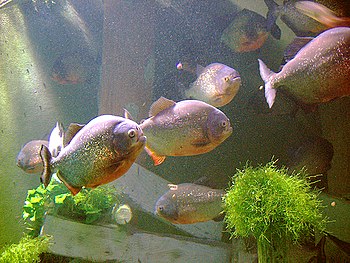| "NeonTetra" by Corpse89 Licensed via Wikimedia Commons. |
Neons are an all-time favorite among freshwater aquarium owners. In any given mouth approximately 1.8 million neon tetras are exported to the US alone. Their petite size most certainly contributes to their popularity. They rarely exceed an inch and a quarter in length. You can keep an entire school of them in an aquarium no bigger than 5 gallons. They are the perfect choice for desktop nano tanks.
These dazzling little beauties will add brilliance and color to any aquarium. The iridescent blue horizontal stripe that runs just above their spines almost glows under aquarium lights. Just below the blue, a second bright red stripe runs from mid-body to the base of their tail. These radiant colors are transposed against a translucent body. Their fins are transparent. You can see right through them.
Neons are by nature a skittish species. They spook rather easily. They are also very small fish that could easily be perceived as a source of nutrition by larger species. They do however make excellent community fish if you take these factors into consideration. An abundance of plants and or rockwork will provide sufficient hiding place and help them feel confident in their new surroundings. Avoid keeping them with species that will grow large enough to ingest them. Following these simple rules will keep your neons healthy, happy and most importantly, alive!
Neons are mid-tank swimmers. They are shoaling fish. Shoaling fish do not cope well when isolated from other members of their own species. Many will not survive in solitude. It is advisable to have at least four neons in your aquarium. This will help to ensure that they adjust well to their new environment.
There is yet another factor to consider when deciding whether these fish are right for your particular aquarium. Tetras are notorious fin nippers. The more neons you have together, the higher the likelihood that this will become a problem. Long, flowing fins like those found on a betta fish or a fancy tailed guppy will most likely prove to be a taste treat tempting to pass up.
This is a hardy species. These omnivores have an extremely high survivability rate in captivity. They are not finicky eaters. A good quality flake food for omnivores is the perfect staple for their dietary needs. The average life expectancy of neon tetras in captivity is 5+ years.
The exportation of species for hobby fish trade began to boom shortly after World War II. Neon tetras were among the first species to be sold under the label, tropical fish. Their introduction to Europe and the US helped to fuel what is now the multi-million dollar aquarium trade industry. At one time these fish commanded an insanely high price tag. Commercial fish farms have since brought their price well within a range of the average aquarium enthusiast and made them one of the most popular fish in the world today.
|





